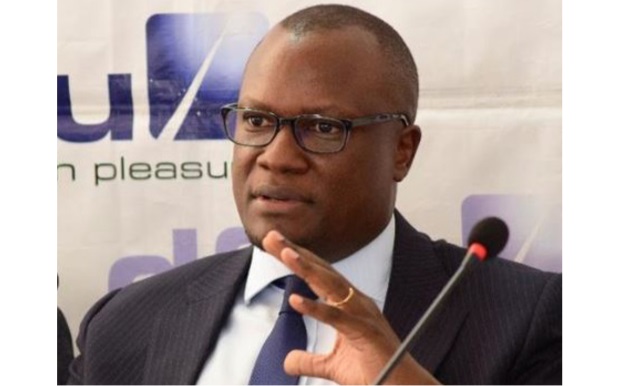
Top managers are optimistic the future of the business is bright
Kampala, Uganda | JULIUS BUSINGE | Shareholders of dfcu would be happier if the bank’s financial accounts showed a decline in costs and increase in revenue. This is not the case for the financial year 2018.
However, dfcu’s top management are optimistic that the lender will make profits in the year ahead.
Financial results released on March 27, indicate that the bank recorded a 52% decline in net profit from Shs127bn in 2017 to Shs61.7bn in 2018.
Mathias Katamba, the bank’s managing director and chief executive officer told journalists and sector analysts at the bank’s headquarters on March 27 that they were not worried about the sharp decline in revenue for 2018 because the year before was unique and had been boosted by ‘a one-off income’ resulting from the acquisition of Crane Bank assets.
In 2018, the bank posted Shs61bn as total comprehensive income, far higher than the Shs127bn recorded in the previous year, which had Shs119bn one-off income accruing from the purchase of Crane Bank.
Meanwhile, the bank’s core business of loans and advances registered a 5%increase, from Shs242bn in 2017 to Shs260bn in 2018.
The annual average growth in private sector credit in the quarter to Dec. 2018 for the entire industry was 11.3%, according to Bank of Uganda data.
Katamba said in 2018, the bank focused on ensuring asset quality of their consolidated book, which reduced impairment expenses by 61% from Shs49bn in 2017 to Shs19bn in 2018.
Customer deposits remained flat at Shs1.9tn for the period under review as the bank focused on a strategy of growing the current and savings deposits that area more cost effective source of funding.
The strategy resulted into 11% reduction in the interest expense from Shs88bn to Shs78bn. Interest on government and other securities declined from Shs98.8bn in 2017 to Shs65.5bn in 2018. Non-funded income in terms of fees and commission increased by 29% from Shs39.3bn to Shs51bn as the bank continued to harness the benefits of the investments in technology and growth in customer base.
Total expenditure reduced from Shs350billion in 2017 to Shs326bn in 2018. But total assets reduced by 5% from Shs3.1tn to Shs2.9tn due to repayment of borrowed funds and subordinated debt.
This resulted in a 39% reduction in the bank’s interest expense from Shs44bn to Shs27bn.The bank paid out Shs22.6bn as tax, lower than Shs41.4bn remitted in 2017.
Katamba said 2018 was not a normal year for the bank but the figures have taken back the bank to its normal performance trend which gives them momentum to normalize the post-merger operations.
“Last year was not an ordinary year but it showed resilience of the institution,” he said.
He said that if it was not for good management, the negative publicity that hit the bank following the acquisition of some assets and liabilities of Crane Bank, the performance would even have been worse.
He said that the stable customer deposits recorded during the year is a justification that its customers are loyal and confident that they are getting value from the bank.
“This is an extremely well run institution,” Katamba said, adding “we managed to achieve that even in a hostile environment.”
The bank recorded a jump in bad debts written off from Shs27bn in 2017 to Shs82bn in 2018. Katamba said that some of these loans were acquired from Crane Bank.
“We didn’t take over the best performing institution,” he said, “These are costs that come with mergers and takeovers.”
William Sekabembe, the bank’s chief of business and executive director was equally positive about the results.
“You don’t have to worry,” he said, “the bank’s capital levels are way above…and it [bank] is extremely liquid.”
Going forward, Sekabembe said that they will be implementing a more cost cutting strategy so as to increase revenue by deploying more new skilled staff at various branches to attend to the bank’s clients.
On the other hand, Katamba, said they are working towards reducing the cost to income ratio currently at 79.5% [registered in 2018] to below 60%.
He said this will be done through strengthening agent banking where they already have 700 agents manning 10% of the total bank’s transactions. The bank aims to have 30% of its total transactions managed by agents in the next 12 months.
“We will continue to be prudent while doing the right things,” Katamba said. The Bank’s Board of Directors has recommended a cash dividend of Shs33.01 per share as opposed to Shs68.24 paid out a year before. This has to be approved by the Annual General Meeting planned for June 13.
While commenting on the entire financial position of the bank, an accountant with over 10 years of experience working at a private company told The Independent that the bank’s position is not bad going by its total assets in comparison with liabilities.
He said the bank must work towards cutting unnecessary operational expenditure by embracing new technology, agent banking and reducing on borrowings.
Listed on the Uganda Securities Exchange, dfcu bank is owned by Arise (Norfund, NorFinance, Rabobank &FMO (58.70%), Commonwealth Development Corporation (9.97%), NSSF (7.46%), Kimberlite (7.35%) and others 16.52%.
****
 The Independent Uganda: You get the Truth we Pay the Price
The Independent Uganda: You get the Truth we Pay the Price


